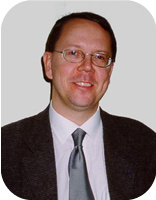|
Swedish
researcher takes part in spring seminar

"Both in Sweden and in the United States, we create extremely dangerous
environments and then expect people to be able to walk and bicycle safely
in them" |
Although Sweden
is a world leader in planning streets that are accessible and safe for
bicyclists and walkers, too much of the country's traffic planning excludes
these modes of transportation and focuses on the automobile, according
to Dr. Lars Ekman, a leading Swedish researcher who visited the University
of North Carolina at Chapel Hill this spring.
As in the United States, people on foot or on bicycle, are often left
to fend for themselves in unsafe environments, Ekman explained in a
presentation at the 2000 Spring Seminar Series sponsored by the UNC
Injury Prevention Research Center. Ekman's talk was co-sponsored by
the UNC Highway Safety Research Center.
"Both in Sweden and in the United States, we create extremely dangerous
environments and then expect people to be able to walk and bicycle safely
in them," Ekman said. "We leave it up to the bicyclists and the pedestrians
to figure out how to be safe."
"We don't do that in other forms of planning," he said. "In houses and
public buildings, we don't have stairs with no rails and a sign that
says: ‘Be careful. Walk close to the wall.' We don't have houses with
electrical wires sticking out all over with signs that say: ‘Do not
touch. Be careful.' Planning, in these situations, is done so that the
environment is as safe as possible for the people who will be using
it. The same thing needs to be done in the traffic planning arena."
Sweden's outlook on transportation planning is changing. Ekman said
the country's National Road Administration recently formulated a new
goal to guide engineers in their traffic safety planning. Called "Vision
Zero" the new plan sets the high aim that "no severe or fatal accidents
shall occur in traffic in Sweden. Although this may seem idealistic
to some, Ekman said it has resulted in a shift in responsibility.
"Traditionally, the main responsibility for safety has been placed on
the user," he said. "The Vision Zero concept places the final responsibility
for safety on the designers of the road system."
top
of page
|

